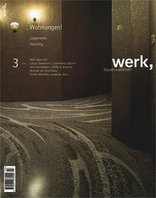Zeitschrift
werk, bauen + wohnen 3-05
Wohnungen!
The „to let“ columns continue to sing the praises of „loft apartments“, apparently assuming that the attribute „loft“ must of necessity refer to something worthwhile and desirable. In fact, however, the term „loft“ has meanwhile degenerated into a commonplace that is often nothing more than a high-flown expression for a hard-to-furnish apartment in which the claim of maximum freedom for the tenant hardly suffices to cover up the architect's failure to achieve a reasonable or even ingenious layout. Yet even in cases where the qualities of the loft have been realised in the best sense of the word, the limitations of this form of accommodation are becoming increasingly evident, for a certain amount of comfort is desirable even for urban monads, and this inevitably conflicts with the principle of the single-room apartment (see wbw 3-2003 „Comfort“). In addition, sheer size and spaciousness alone prove to be inadequate qualities. Why should someone who can afford the luxury of spaciousness forego the quality of variety in terms of differentiated spatial situations? Is not one big room, however impressive it may be at first glance, boring in the long run? In this situation, it is not surprising that bourgeois apartments, particularly those dating from the transition to the 20th century, are once again attracting attention. Their differentiated rooms are still attractive despite the fact that the functional reasons for this differentiation have long ceased to be relevant. And it has become clear that rooms with a specific character and spatial variety evidence qualities which by no means stand in the way of a new appropriation.
There is, however, no reason to suppose that this represents a demand for a reversion to historical housing types or even forms. Nevertheless, apartments with large and small rooms, open and introverted, light-flooded and shadowy areas, are certainly not absurd, even though their utilisation can no longer be preordained as parents' and children's rooms, dining or whatsoever-rooms. To presume the demand for uniform, „neutral“ rooms from the proverbial diversity of today's forms of living and housing, would, however, to be labouring under a misapprehension, also in terms of rented apartments.
„After the loft“ has been the working title of this issue for some time, because in recent times we have seen numerous signs that diversity, i.e. rooms with clear individual characteristics, are becoming increasingly sought-after in urban housing. We have gathered together some widely varying examples with one thing in common: they are all not mere inhabitable spaces, but homes.
The editors
Thema
Daniel Kurz
Nach dem Loft | Individuelles Wohnen in städtischer Dichte
Elli Mosayebi
Wege und Räume | Wohnungen des Mailänder Architekten Luigi Caccia Dominioni
Philipp Esch
Höhlen in der Steilwand | Genossenschaftliche Wohnüberbauung in Zürich-Leimbach von pool-Architekten
Marie-Therese Stauffer
Komplexität, Kontrolle und laisser faire | Zum Wohnhaus von Andreas Fuhrimann und Gabrielle Hächler am Üetliberg, Zürich
Gian-Marco Jenatsch
Wohnen im Park | Wohnhaus «Schwarzpark » in Basel von Miller & Maranta
Christoph Wieser
Wohnlabor | Studienauftrag «Im Forster », Zürich 2004
Forum
Kolumne: Judith Fischer
Bauten: Wohnhaus Altstetterstrasse 278, Zürich von Guignard & Saner
Architekten EFH: Wohn-und Atelierhaus in Monthey VS,von Bonnard Woeffray Architekten
Wettbewerb: ETHZ und EPFL enthüllen ihr projets
présidentiels
Wettbewerb:Learning Center EPFL
bauen +rechten
Bücher: Design hören
Innenarchitektur: Herrengasse 36, Bern
Ausstellungen | Veranstaltungen | Wettbewerbe | Neuerscheinungen | Produkte Vorschau | Impressum
werk-Material
Andreas Fuhrimann, Gabrielle Hächler, Architekten Zürich:
Mehrfamilienhaus am Fusse des Üetlibergs, Zürich
Guignard & Saner Architekten, Zürich:
Zehnfamilienhaus Altstetterstrasse 278, Zürich
There is, however, no reason to suppose that this represents a demand for a reversion to historical housing types or even forms. Nevertheless, apartments with large and small rooms, open and introverted, light-flooded and shadowy areas, are certainly not absurd, even though their utilisation can no longer be preordained as parents' and children's rooms, dining or whatsoever-rooms. To presume the demand for uniform, „neutral“ rooms from the proverbial diversity of today's forms of living and housing, would, however, to be labouring under a misapprehension, also in terms of rented apartments.
„After the loft“ has been the working title of this issue for some time, because in recent times we have seen numerous signs that diversity, i.e. rooms with clear individual characteristics, are becoming increasingly sought-after in urban housing. We have gathered together some widely varying examples with one thing in common: they are all not mere inhabitable spaces, but homes.
The editors
Thema
Daniel Kurz
Nach dem Loft | Individuelles Wohnen in städtischer Dichte
Elli Mosayebi
Wege und Räume | Wohnungen des Mailänder Architekten Luigi Caccia Dominioni
Philipp Esch
Höhlen in der Steilwand | Genossenschaftliche Wohnüberbauung in Zürich-Leimbach von pool-Architekten
Marie-Therese Stauffer
Komplexität, Kontrolle und laisser faire | Zum Wohnhaus von Andreas Fuhrimann und Gabrielle Hächler am Üetliberg, Zürich
Gian-Marco Jenatsch
Wohnen im Park | Wohnhaus «Schwarzpark » in Basel von Miller & Maranta
Christoph Wieser
Wohnlabor | Studienauftrag «Im Forster », Zürich 2004
Forum
Kolumne: Judith Fischer
Bauten: Wohnhaus Altstetterstrasse 278, Zürich von Guignard & Saner
Architekten EFH: Wohn-und Atelierhaus in Monthey VS,von Bonnard Woeffray Architekten
Wettbewerb: ETHZ und EPFL enthüllen ihr projets
présidentiels
Wettbewerb:Learning Center EPFL
bauen +rechten
Bücher: Design hören
Innenarchitektur: Herrengasse 36, Bern
Ausstellungen | Veranstaltungen | Wettbewerbe | Neuerscheinungen | Produkte Vorschau | Impressum
werk-Material
Andreas Fuhrimann, Gabrielle Hächler, Architekten Zürich:
Mehrfamilienhaus am Fusse des Üetlibergs, Zürich
Guignard & Saner Architekten, Zürich:
Zehnfamilienhaus Altstetterstrasse 278, Zürich
Weiterführende Links:
Verlag Werk AG







